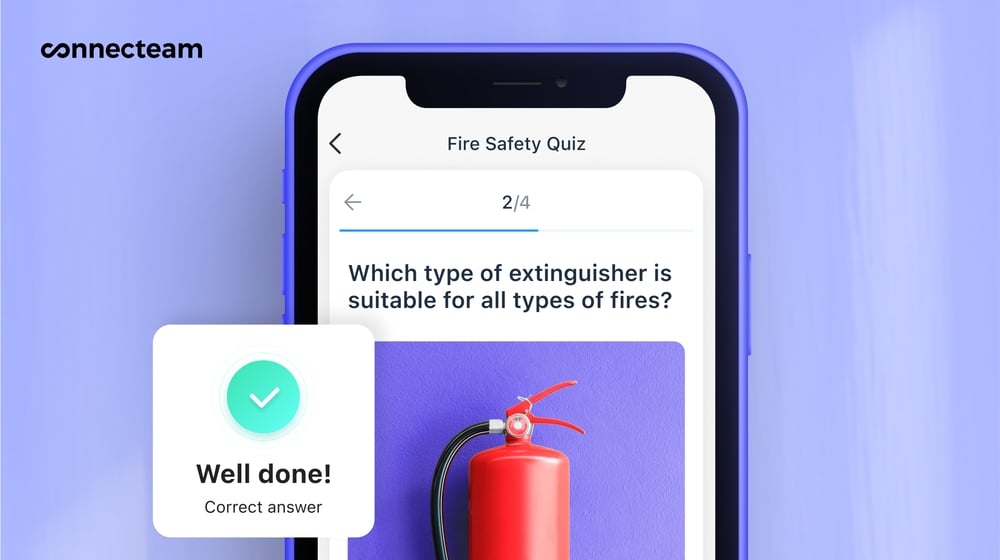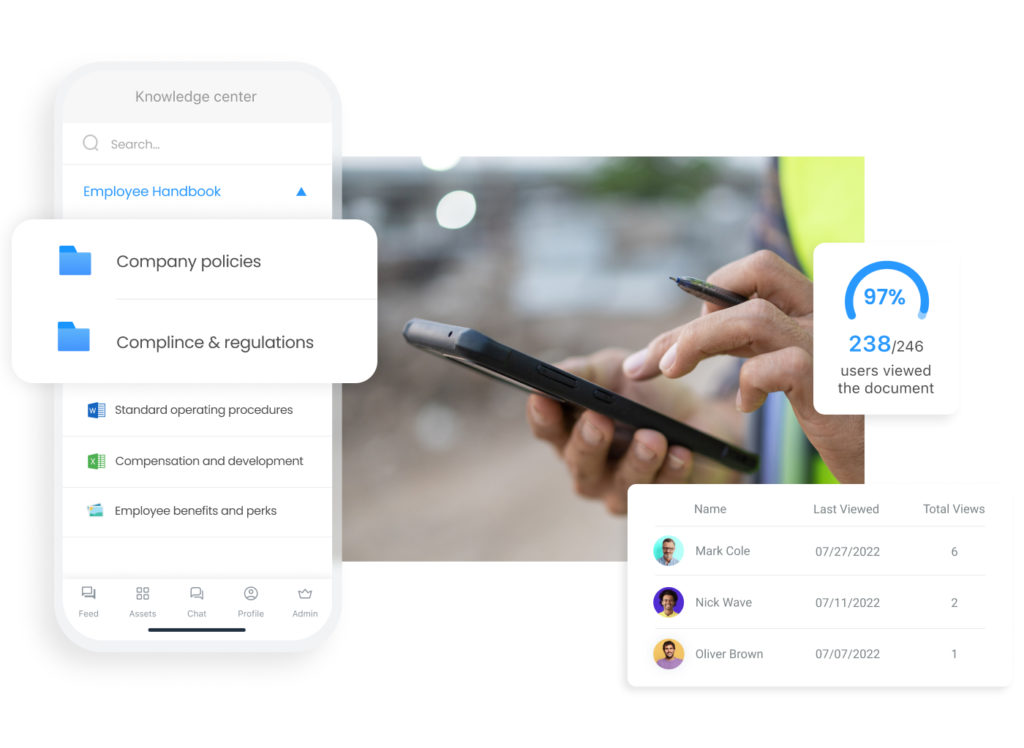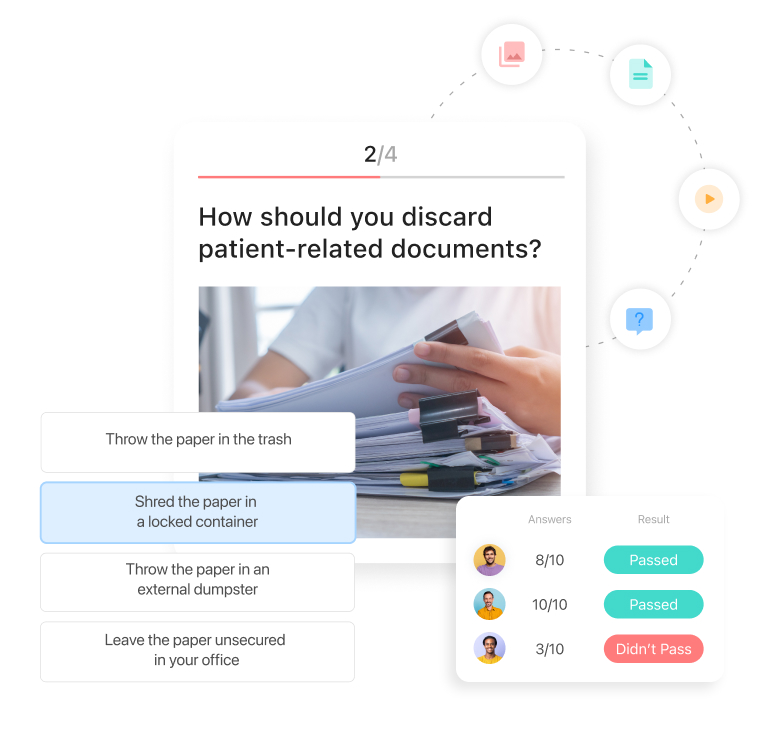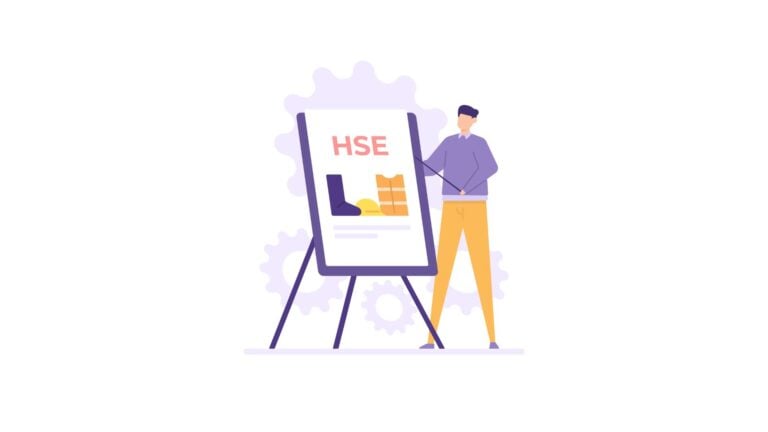Compliance training is required by law and helps you build and maintain a safe and ethical working environment. Learn what compliance training is, how it protects your workers and company reputation, and the best way to roll out training in your organization.
On average, companies in the US spend nearly $15 million per year on compliance issues. In addition to fines, companies often face major consequences for non-compliance. They can spend millions in legal battles, lose company licenses, and face permanent damage to their reputation.
That is why it’s essential to stay compliant with industry regulations and labor laws. You need to ensure that every worker in your company knows the rules and is well-trained in how to follow them.
In this guide, we explain what compliance training for employees is and why it’s critical to company success. Plus, we share our top tips on how to create and run an effective compliance training program at your company.
Key Takeaways
- Compliance training educates workers on compliance issues such as workplace safety, quality control, discrimination, bribery, and more.
- Without the right training, workers can make costly mistakes that could result in legal action, fines, and other consequences.
- The best way to run compliance training is to tailor it to your industry, be consistent, gather feedback, and automate the process.
- Connecteam lets you do all this and much more from one central platform.
What Is Employee Compliance Training?
Compliance training is the process of educating employees on working practices they’re legally required to adhere to. This covers complying with:
- External regulations, such as industry laws, anti-harassment policies, safety regulations, etc.
- Internal regulations, such as company policies, ethical practices, code of conduct, and so on.
The purpose of compliance training is to ensure that employees understand the rules and how to follow them.
This helps you provide high-quality products and services and keeps your workers and customers safe. Plus, it greatly reduces the risk of being sued by employees, customers, and other stakeholders or facing heavy non-compliance fines by regulatory bodies.
Pro Tip
Use a dedicated employee training app like Connecteam to quickly create and deliver mobile training courses for your frontline teams they can complete from anywhere. Quiz your staff directly in the app after the training is complete ensure they’re always up-to-date with the latest regulations and fully compliant.
Get started with Connecteam for free today!

Examples of Compliance Issues That Require Training
Here are some examples of compliance issues and the training required to address them.
Occupational health and safety
Many companies—for instance, in the construction industry—operate in hazardous environments. Moreover, some industries deal with products and services that can present a risk to employee safety. For example, incorrect healthcare practices can put workers’ health at risk through the spread of illness.
Businesses in these types of industries have to follow strict health and safety rules. These rules are mandated by law under the Occupational Safety and Health Administration Act (OSHA). Non-compliance could lead to employees losing their licenses and workers and companies suffering damage to their reputations.

Health and safety compliance training focuses on educating employees about these regulations. It involves training workers on:
- The risks and hazards within their line of work
- Fire safety
- Preventative measures to reduce accidents, injuries, and other health risks
- Proper use of equipment or machinery
- Emergency procedures
- How to create incident reports
Industry-specific regulations
Different industries may have specific compliance requirements. The International Organization for Standardization (ISO) lays down the required standards for various industries.
For example, food and beverage companies have to follow specific practices to ensure that food is safe to consume. Compliance training would teach food service workers about:
- Food safety regulations
- Handling allergens
- Storing prepared food
- Proper cleaning and sanitizing practices
- Environmental regulations
- Waste management
Regulatory bodies, like the Food and Drug Administration (FDA), set out and enforce these laws. Non-compliance can put customers’ health at risk and result in the establishment losing its license and even facing legal action.
Standardization, quality control, and product safety
Industries such as manufacturing have strict rules when it comes to production quality. For instance, products may need to be made using a certain quality of material. Plus, they’d need to be fit for use and free of defects.
Companies in this space have to conduct a quality assurance check before selling their items. They could sell a product that’s defective or dangerous to use if they don’t comply. They would also put themselves at risk of being sued by customers or other stakeholders.
In addition to external rules, companies may also have internal processes to ensure consistency in their products. For example, in a restaurant, workers need to follow an exact recipe and use the same ingredients when preparing something. This way, they can ensure they’re providing food that meets a high standard and is the same every time.
Quality control and standardization training educates workers on:
- Product manufacturing or creation process
- Proper handling of materials
- Product inspections
- Quality control process and measures

Licenses and certification requirements
In certain industries, workers are legally required to have licenses or certifications to be able to do their jobs. Nurses and doctors, for instance, need a medical license to work. Similarly, in many states electricians also require licenses and certifications.
Another example is construction businesses, where both workers and the company itself need licenses to operate. You could face steep legal fines or even be charged with a felony if you operate without a license.
Licensing and certification training would educate workers and managers on:
- What certifications or licenses they need
- How to obtain them
- Training courses to prepare for any potential tests or exams
- The importance of renewing documents and how to renew them
This Might Interest You
Read our complete guide to employee record management to learn the best ways to store and manage licenses, certifications, and more.
Check out these 9 construction certifications to advance your career and company
Workplace harassment, violence, and discrimination
In addition to company policies, there are legal regulations that workers need to follow when it comes to harassment, violence, and discrimination. By following these laws, companies can foster a safe working environment for all employees.
They also ensure that all workers are treated fairly and equally without any discrimination based on race, sex, age, gender, nationality, disability, and so on.
Most states require companies to add anti-harassment and anti-discrimination policies to their employee handbooks. Non-compliance could result in companies being sued by their workers and losing their reputation with stakeholders.
Anti-harassment and anti-discrimination training educates workers on:
- What behaviors constitute harassment, violence, and discrimination
- How to prevent discrimination through diversity, equality, and inclusion (DEI) training
- Preventing bullying and violence at work, including cyberbullying
- Reporting incidents of discrimination and harassment, including sexual harassment
- The company’s procedures for dealing with these cases
- Employees’ legal rights when it comes to harassment and discrimination
Data privacy and security
Companies are required to protect certain data when doing business.
For example, healthcare companies need to ensure that sensitive customer information, including personal data and medical histories, is stored securely. Workers receive training focused on safeguarding Protected Health Information (PHI) under the Health Insurance Portability and Accountability Act (HIPPA).
Businesses ensure data protection through end-to-end data encryption, two-factor authentication, access permission controls, secure cloud-based data storage, and other measures. Data breaches can result in legal action by customers or the authorities.
Companies often also have an internal policy to protect confidential information. This information could be personnel records, customer data, working practices, or any other important company document. Most employees will find a section about confidentiality and non-disclosure in their employment agreements.
Data privacy and security training teaches workers about:
- The importance of protecting sensitive data
- Data handling best practices
- Data breach prevention
- Proper use of communication channels and technology to maintain data security
- Setting up the right permission and access controls
This Might Interest You
Explore our guide to the best compliance management software to see how the right tools can help ensure data security, maintain regulatory compliance, and streamline employee training on data protection practices. With dedicated software, you can safeguard sensitive information, enforce confidentiality policies, and keep your business aligned with essential compliance standards.
Cybersecurity
Cybersecurity is the practice of protecting a company’s online systems and networks from digital attacks such as hacking.
Most companies that use online systems need to ensure that company data and sensitive information aren’t leaked. Otherwise, they’re at risk of losing company secrets. In more extreme cases, companies can also be victims of financial theft through cyberattacks.
Cybersecurity training aims to educate employees on:
- Potential cyber threats, such as hacking, phishing attacks, malware, and more
- How to recognize and report suspicious activities
- Creating strong passwords
- Practicing safe browsing habits
Ethical business
Most companies aim to adhere to regulations that are focused on ethical business practices.
These help promote ethical behavior and integrity at work.
Regulations could be external, such as anti-money laundering regulations, insider trading laws, the Sarbanes-Oxley Act (Prevention of Accounting Fraud), and so on. These affect workers and companies as a whole.
Regulations could also be internal company policies, such as conflicts of interest, anti-bribery, and more. Workers who don’t comply with these rules can have their employment terminated and, in some cases, face criminal charges.
Business ethics training helps workers understand:
- Their ethical responsibilities from a legal and internal company perspective
- What actions/behaviors are and aren’t permitted
- Whistleblowing and reporting unethical work practices
- The consequences of non-compliance
Employment laws
Any company that has employees needs to ensure that they’re complying with their local, state, and federal employment laws.
For instance, there are specific laws in place to ensure minimum hourly wage, rest breaks, time off, and more. Another example concerns company benefits. In the US, any company with 50 or more employees has to provide workers with unpaid leave under the Family and Medical Leave Act (FMLA).
There are many employment laws in place to protect workers. Companies that don’t comply can be victims of heavy fines or even legal action.
HR law training aims to help HR professionals or company leaders understand:
- Key employment regulations
- Labor laws that relate to hiring, employee management, and termination
- Equal opportunities training
- Fair labor standards
- Best practices to stay compliant
Benefits of Compliance Training
Prevents legal and financial penalties
Compliance training ensures that workers know what rules and regulations they need to follow in their jobs. It also helps them understand what they can and can’t do to stay compliant. Further, it ensures that workers have the certificates and licenses they need to do their jobs.
With compliance training, workers are less likely to make costly errors that could result in your company getting fined or sued.
Protects the company’s trade secrets and sensitive data
Compliance training teaches employees about best practices to protect the company from fraud, data leaks, and more. It also helps them understand what tools they can use to do this—for instance, permission controls and two-factor authentication. This way, your company can keep its data secure—and with that, your competitive advantage.
In keeping data secure, workers are also protecting other sensitive data like customer or employee information. This helps protect your business from facing legal problems under data protection laws.

Creates a safe working environment for employees
Compliance training educates employees on topics like workplace harassment, discrimination, violence, and so on. Workers are taught about their rights at work and how to identify and report red flags. This helps build a safe working environment at your organization.
Pro Tip
An employee handbook is a great place to store company policies and the code of conduct. You can use our handy guide to create your own company handbook today and use Connecteam’s employee training tool to disseminate the information.
Get started with Connecteam for free today!
Helps uphold values of ethical and honest practices
Compliance training helps workers understand the importance of conducting ethical business. Workers learn what constitutes unethical practices—for example, bribery and insider trading.
Employees are more likely to work with honesty and integrity when they’re fully aware of what is and isn’t permitted. Plus, they’re given the tools they need to blow the whistle if they spot any suspicious activity in the company. This way, they’re trained to help uphold core company values.
Increases sales with better-quality products
Companies that stay compliant with industry standards, quality checks, and other compliance rules are likely to create solid and reliable products.
Good products speak for themselves. They bring more revenue and create a good reputation for the company in the market, helping you attract more customers.
Builds a good external reputation
Creating products that are high-quality can help build a good reputation for your company.
Additionally, safe and ethical business practices also help customers, investors, and other stakeholders feel comfortable doing business with you.
Finally, treating workers fairly and being a compliant employer can help attract talent in the job market.
Boosts productivity and efficiency
Employees work faster, better, and with fewer errors when they’re well-trained on how to create high-standard products.
Compliance training also helps team members better understand the company’s values. This could be related to business practices such as honesty and integrity. Plus, it can help show them the company’s stance on internal factors such as bullying.
Overall, workers who can relate to organizational values and feel safe at work are more likely to stay engaged and productive.
Best Practices for Compliance Training Programs
An employee compliance training program must be run effectively for it to be beneficial. Here are some best practices to follow when running your compliance training program.
Identify training needs and tailor your modules accordingly
Understand what laws and regulations apply to your company.
First, consider what locations you operate from, the industry you’re in, and how many employees you have. You can find the applicable laws on the websites of relevant regulatory bodies. For example, you can find federal employment laws on the Department of Labor website. Similarly, you can find safety laws on the official OSHA website.
Pro Tip
Since it’s tricky to find all the applicable laws in one place, consider consulting a compliance expert. You can then create compliance training modules to cover each compliance issue that applies to your company.

Clear communicate training information and deadlines
Your workers need to know what training they need to complete and by when.
For instance, you can send them an email to share information and a link to their online course. For classroom training, send them a calendar invite. Tell them what the course is, if they need to do any pre-work, and when and where they need to attend the course.
It’s also critical to ensure that you clearly outline deadlines for employees’ compliance training courses. This is especially relevant to online courses that they’re completing at their own pace.
Be consistent and regular in training
Compliance training isn’t a one-time requirement. Laws can change, so it’s important to keep workers up to date with the latest rules and how to follow them.
Speak to your in-house compliance expert or an external consultant regularly to understand if there are any changes to the laws that apply to your business.
If laws have changed, it’s important to update course content to reflect any amendments that have been made.
If laws stay unchanged, you can either re-run the same compliance courses regularly—for instance, every 6 months. Alternatively, you can create and assign refresher courses to keep topics up-to-date and relevant.
Use a variety of training methods
Blended—or mixed—learning is the best way to help workers retain information. This type of learning involves using different learning techniques, such as classroom training, online training, and on-the-job learning.
You can use different forms of learning for different teams too. For instance, in the case of a restaurant, you may want to teach employees how to standardize recipes through a mix of classroom training and on-the-job learning.
This Might Interest You
Read our piece on how mobile learning solutions are changing compliance training.
Make it engaging
Compliance training covers topics that are extremely important but aren’t always very exciting. Make your modules more engaging by adding quizzes, real-life simulations, gamification elements, and more.
These help make learning fun—but you can also use these as ways to test your workers’ understanding of key concepts.
Evaluate the effectiveness of training
Gather regular feedback on your compliance training programs. You can do this through check-ins with employees. Alternatively, you can send employees an online survey to gather their feedback and suggestions.
Did You Know?
Connecteam enables you to create and publish employee surveys and polls in minutes. This is a great way to collect feedback on your compliance training courses.
Get started with Connecteam for free today!
Automate the process
With so many topics to cover, creating and running compliance training modules can be a manual and time-consuming task. You also need to be able to track that workers are completing their programs on time.
The best way to run your compliance training programs is by automating the process. This means conducting employee compliance training digitally. You can do this by using specialized training software.
Typically, this software allows you to create custom compliance training courses using templates or easy drag-and-drop builders. You can also add quizzes to test learning through the modules.
Once published, workers are notified of the compliance training course they need to complete. You can track progress and send them reminders to complete their training.
Below, we’ve detailed how you can run your end-to-end compliance training using Connecteam, the best all-in-one compliance training solution.
Setting up a Compliance Training Program with Connecteam
Let’s take a look at Connecteam’s key compliance training features.
Create custom training modules in minutes
Connecteam lets you create compliance training courses quickly using templates. You can also build custom training modules from scratch with just a few touches or clicks of your device.
The training feature supports images, videos, PDFs, and more. This way, you can use different methods to make the content fun and engaging.
Plus, you can divide courses into bite-sized chunks and customize the formatting to your preference. You’re also able to add quizzes to your compliance training modules to check how well workers are retaining key information.

Connecteam’s mobile-first approach ensures workers can access and complete courses from anywhere. They receive automated reminders to finish training, and you can view their progress in real time from the central dashboard.
Store all compliance training content in one centralized knowledge center
Connecteam enables you to create a knowledge base, where you can store all your compliance training documents and guides (and any other company documents). This could include safety manuals, standard operating procedures (SOPs), the company handbook, and more.
The knowledge base supports images, videos, docs, PDFs, and even audio clips so you can store and manage content in whatever format you want. There’s also no limit on file sizes and no storage limit overall.
Workers can access any compliance guidance straight from their mobile devices. They get the answers they need instantly without any back and forth.
View workers’ compliance histories and licenses easily from their timeline
Connecteam also lets you view your workers’ employment histories, training statuses, and certifications and licenses via the timeline feature.
You can see when their certifications or licenses are expiring so you’re always organized. Plus, you can add compliance training modules and refresher courses to their timelines so they’re notified of any training they need to complete.

Stay compliant with industry regulations using forms and checklists
With Connecteam’s custom checklists, workers remember to complete essential tasks, such as end-of-day protocol and safety checks. They can also file incident reports and more using Connecteam’s forms feature. You can track progress and see updates to forms and checklists in real time.
In addition to all this, Connecteam has an in-app chat you can use to communicate with your employees individually or in groups. Messages are sent in real time, and chat data is stored securely in the cloud. The company newsfeed is also an easy way to let everyone know when a new training module has been published.
With all these tools and so many more, Connecteam makes it easy to run your compliance training programs.
Conclusion
Compliance training educates employees on the laws and regulations they need to adhere to at work. Without the right training, workers are more likely to make costly mistakes that result in steep fines, loss of licenses, or legal action against your company.
That is why it’s vital to have a solid compliance training program in place at your company. You can train your employees on safety standards, ethical working, discrimination, and more.
That said, it can be tiresome to create and run compliance training. Use dedicated training software like Connecteam to automate the entire process. You can create and assign custom training content, store compliance guides, and view your workers’ training histories, certificates, and licenses all from one place.
Get started with Connecteam for free today!
FAQs
How do you create employee compliance training online?
You can run compliance training courses online using a learning management system (LMS) or all-in-one work management platform like Connecteam. Create your courses easily using templates, build custom courses from scratch, send completion reminders, and track workers’ progress in real time. Connecteam also offers mobile learning so workers can complete their courses from anywhere.
Who is responsible for compliance?
Every worker and manager in the company must comply with company rules and external laws. Proper compliance training helps workers understand the rules and how to adhere to them. It also emphasizes workers’ roles in staying compliant and the consequences of non-compliance.



